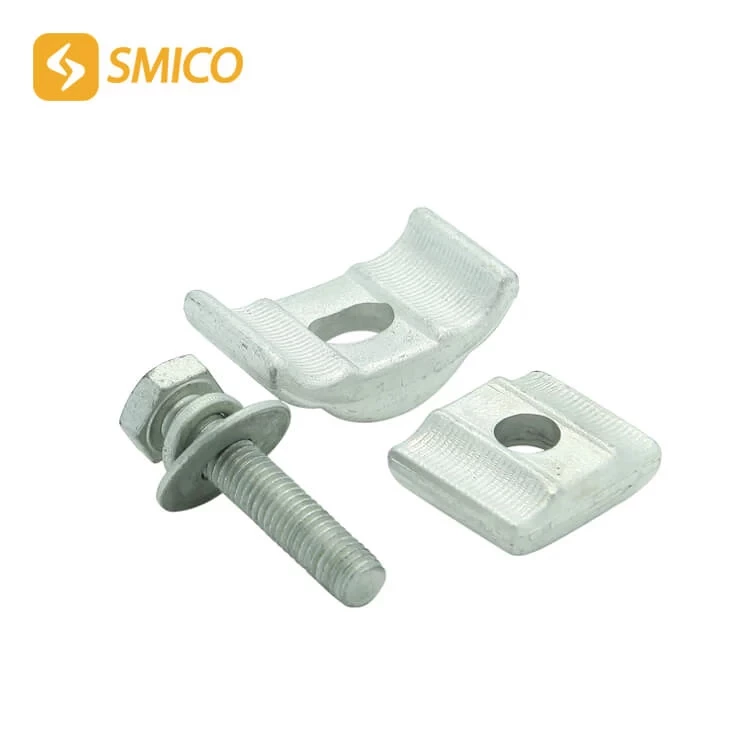Cause Analysis And Solution Of The Accident Of The Wire Clamp In The Trench Of The Tension Tower Drainage Line
3.1 Impact of the operating environment
The drainage parallel groove clamp is operated in the open air, exposed to wind, rain, and sun without any protective measures. In addition, environmental pollution is becoming more and more serious, so corrosion and oxidation are serious, the surface is black and discolored, and the gaskets and spring washers of some parallel groove connector are bonded together due to severe rust. Some gaskets have even been corroded, and some bolts have been rusted and cannot be turned; moisture, acid rain and corrosive gases are adsorbed on the surface of aluminium pg clamp and the wire, and a large amount of dust enters the contact surface of bimetal pg clamp along the gap of the wire and accumulates on the edge of the contact indentation. Therefore, when the contact pressure drops, the wire shakes, the contact surface produces micro-motion and under the action of a strong electromagnetic field, pollutants enter the actual contact indentation, which increases the contact resistance and forms a potential difference between blackburn parallel groove clamp and the contact surface of the wire. When the potential difference reaches the arc starting voltage, an arc will be generated to burn the wire.
3.2 Structural problems of burndy parallel groove clamp
When installing connector parallel groove,, it is not easy to obtain high and uniform tightening torque for each bolt, which makes the contact pressure of each part unequal, the electric field distribution uneven, causing local overheating and expansion, and the contact surface position is staggered, which is oxidized after staggering. When the temperature drops and returns to the original contact position, it is impossible to restore the original direct contact between the metals due to the coverage of the oxide film. The increased contact resistance of each temperature change cycle increases the heat of the next cycle, and the higher temperature further deteriorates the contact resistance. This vicious cycle causes the contact pressure to continue to decrease, causing serious plastic deformation of some gaskets, and the spring gasket also loses its elasticity, so that the reduced contact pressure cannot be compensated, resulting in a decrease in electrical contact performance; at the same time, under the influence of wire shaking and air pollution, pollutants such as dust and organic gas can easily enter the contact interface, further leading to poor contact.
3.2 Materials, processes and installation quality
3.2.1 groove clamp is an aluminum-silicon binary alloy. The content of silicon and impurities in the alloy will directly affect the mechanical and electrical properties of the parallel groove body. At the same time, due to some obvious casting defects of parallel groove clamp connector itself, such as shrinkage, pores, irregular shape, etc., the contact surface is uneven and rough, which will directly affect the mechanical and electrical properties of pg clamp connector.
3.2.2 The installation was not carried out according to the process requirements, and there are inherent hidden dangers. Some pg clamps grooves are too deep and the wires are too thin, which makes it easy for external pollutants such as dust and rainwater to enter the single bolt parallel groove connector contact surface along the gap, increasing the contact resistance; the surface is uneven during construction, the contact surface is not tight, and the contact resistance is increased.
3.2.3 The line load is too large, the increase in temperature will reduce the contact pressure, and the decrease in contact pressure will increase the contact resistance.
3.2.4 The maintenance is not in place, mainly manifested in not checking and tightening the connection bolts according to the prescribed cycle, resulting in loose bolts, uneven force, poor surface contact, and increased contact resistance.
3.2.5 Connection of wires of different specifications. The contact surface is not tight. After tightening the bolts, the larger ones are compressed, while the smaller ones still have gaps. The contact surface is poor and the contact resistance increases.

